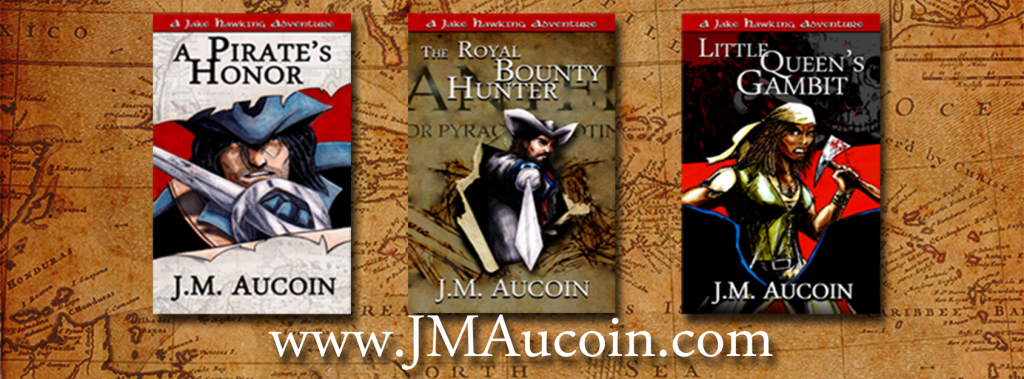Today, I’m thrilled to have author J.M. Aucoin sharing the how and the why of his writing process – and some of the nuts and bolts of writing sword fighting and fencing scenes. Or should I say, some of the finer points… When not writing about sword fights in his swashbuckling pirate fiction, Aucoin practices and studies historical fencing, and is an active stage combatant for theater and indie-films in the New England area.
For the Love of the Sword: The Art & Science of Swashbucklers
by J.M. Aucoin
I fell in love with historical fiction at the tip of a sword. I went willingly, of course. The only thing more attracted by the unknown and shiny objects than puppies and kittens are small children, and I was just that, easily enchanted by the intricate hilts of rapiers hanging at men’s sides and the glint of bare steel in their hands.
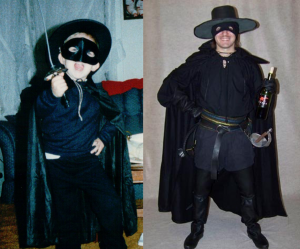 My captors were the likes of Guy William’s Zorro and Chris O’Donnell’s D’Artagan. I must’ve gone as Zorro for Halloween a good four or five years in a row as a kid. Stories of men putting life and limb on the line for a purpose greater than themselves had my full attention, especially if they wielded a rapier.
My captors were the likes of Guy William’s Zorro and Chris O’Donnell’s D’Artagan. I must’ve gone as Zorro for Halloween a good four or five years in a row as a kid. Stories of men putting life and limb on the line for a purpose greater than themselves had my full attention, especially if they wielded a rapier.
Of course, it wasn’t until college that I came up with the brilliant idea of reading the stories I loved as a small child. Swashbucklers in book form! What sorcery is this!?
I started off with Dumas’ Three Musketeers, ripped through Rafael Sabatini’s Captain Blood, Scaramouche, The Sea-Hawk, and The Tavern Knight. Still parched for more romanticized adventure novels, I stumbled across Arturo Pérez-Reverte’s Captain Alatriste series.
Yet, it wasn’t enough to quench my thirst for historical adventure, and I was finding it harder and harder to find swashbucklers, especially by contemporary authors. Straight up historical fiction novels were everywhere. Same with historical mysteries. They’re great stories, but, for me, it was the swashbuckler that held my heart enthralled.
I wanted more. A lot more. So I started writing my own swashbucklers, tales of men forged in blood and steel.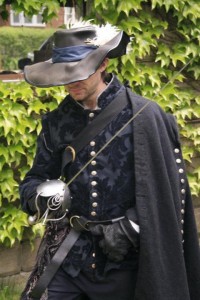
I love modern day action movies, where guns and C4 are as common as ponchos at a Gallagher event. But often with firearms, it’s usually kill or be killed. There’s not a ton of middle ground when it comes to firing a metal projective at someone. But with the sword there’s an entire spectrum to play with. It can be used offensively, defensively. The sword can be a weapon to kill. It can be used to just injure someone or to save a life. And in my earliest exposure to the swords and swashbuckling, it’s a weapon that can bring liberty to the oppressed and justice to the wicked and nefarious.
Not to say I don’t enjoy a good wheellock pistol, though. Man, those things are a work of art… but I digress.
Writing the Fight: What to Keep in Mind
Writing a great fight scene can be tricky and it only gets trickier the more you know about swords and period fencing. I could write a detailed action sequence in which Fighter A steps into measure and gains Fighter B’s sword on the outside line using seconde and stringering Fighter B’s blade, forcing Fighter B to perform a cavazione to the inside line, turning his hand into quarte, and thrusting with a passing step… but the average reader isn’t going to know what the heck just happened.
Then again… if my character is a fencing master in the Italian style, I might write just that. Still, there are ways to make it more accessible to the average reader.
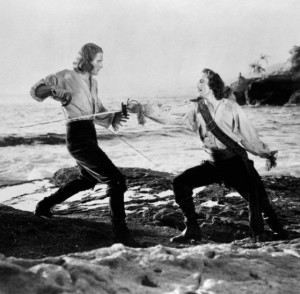 And that’s one of the great things about swashbucklers — they make transporting readers back through time very accessible. You don’t need to know the political history of a country or understand why the Catholics and Protestants are at each other’s throats again to get a swashbuckler. Put two men in a courtyard with harsh glares, gritted teeth and cold steel, and your reader knows right away that these two aren’t likely to go grab a beer with each other afterwards.
And that’s one of the great things about swashbucklers — they make transporting readers back through time very accessible. You don’t need to know the political history of a country or understand why the Catholics and Protestants are at each other’s throats again to get a swashbuckler. Put two men in a courtyard with harsh glares, gritted teeth and cold steel, and your reader knows right away that these two aren’t likely to go grab a beer with each other afterwards.
You also can learn a lot about someone during a sword fight. How they hold the sword: do they use a traditional grip or Girard Thibault’s unorthodox grip? How they stand: are they leaning forward ready to strike like a viper, or leaning back defensively? Are they aggressive or defensive? Are they fencing masters, street thugs, sell-swords, noblemen, soldiers, or complete amateurs who don’t even know that the knuckle guard faces out and not in? Are they cool and collected or hot headed? Do they prefer large sweeping cuts or finesse blade work and thrusts?
Even the type of sword they wield can give insight into the character. A guard or blade with lots of knicks and scratches will tip a reader off that the wielder has been in plenty of scrums before, and the fact that he’s still alive notes that he’s good. Very good. A hilt with intricate metalwork, twists and curves, detailed piercework, or jewels will mark a man of quality (or at least a man of wealth). Cup-hilt rapiers were favored by the Spanish for their hand protection, meanwhile the Germans enjoyed the look and functionality of the Pappenheimer rapier. Of course, hilt types didn’t know country borders, so a Frenchman could use a cup-hilt if they (or you) prefer, but it’s a good starting point.
Time period matters, as well. Your 17th Century Frenchman isn’t going to be wielding a German longsword, and your Roman gladiator isn’t going to be carrying a spadroon into battle either.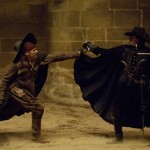
And, of course, there are more than just swords. You have daggers, axes, cloaks, bucklers, shields, canes, whips, pistols, and found weapons like hats, mugs, candelabras, and anything else you can come up with. All that can come into play during a fight, depending on location, availability, and your character’s preference and skill set.
One-on-one fights often feel like they’re a lot longer than they are. Ask two people to sword fight for a minute and they’ll probably stop at 20 seconds. But add in a few more fighters and things get more chaotic and minutes feel like seconds. Time flies when your defending yourself against five guys with sharp swords, right?
I try to keep all this in mind when crafting my fight scenes. Like in movies and live theater, sword fights in novels should continue the story forward, allowing the personalities, emotions, and experiences of the characters to shine.
And don’t forget about the environment, too! Fighting on sand is hard. Your feet sink. Morning dew makes grass slick, and cobblestone streets aren’t very even. You character could trip if they’re not on their A-game. Environmental hazards that can play a role in the fight.
Putting Knowledge into Practice: The Jake Hawking Adventures
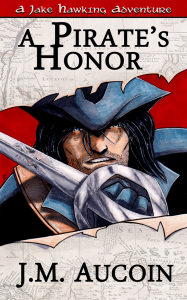 This summer I self-published three swashbuckling short-stories, the first of the Jake Hawking Adventures. The stories are intertwined a little, but are episodic and can be read in any order you please. Jake Hawking is more of a cerebral pirate, very much in the vein of Sabatini’s dashing hero Captain Peter Blood. He enjoys outwitting his opponents over direct combat, but he doesn’t shy from swordplay when it comes to it. Hawking is a fellow who often has his foot in two worlds — one with the gentry and men and women of privilege, and one in the violent and licentious world of pirates and smugglers — and his fighting style echoes that. His skill is technically sound but can be vicious and ruthless when needed.
This summer I self-published three swashbuckling short-stories, the first of the Jake Hawking Adventures. The stories are intertwined a little, but are episodic and can be read in any order you please. Jake Hawking is more of a cerebral pirate, very much in the vein of Sabatini’s dashing hero Captain Peter Blood. He enjoys outwitting his opponents over direct combat, but he doesn’t shy from swordplay when it comes to it. Hawking is a fellow who often has his foot in two worlds — one with the gentry and men and women of privilege, and one in the violent and licentious world of pirates and smugglers — and his fighting style echoes that. His skill is technically sound but can be vicious and ruthless when needed.
In comparison, his quartermaster is the former ex-slaved, Little Queen. She’s tall, muscular, and more likely to crack someone’s skull for looking at her cross than attempt to talk her way out of a bad situation. She’s the ying to Hawking’s yang, and to help facilitate that brutality and grit, I have her using a large, mean-looking dagger and a boarding axe as her preferred weapons. They’re weapons that force her to get up close and personal with her adversaries.
Here’s a snippet of a fight from the third Hawking short-story, Little Queen’s Gambit. In it, Little Queen is fighting her recently acquainted rival, Marshall, who (unofficially) beat her in an arm-wrestling contest earlier in the night. Sometimes things just escalate to unreal scenarios, OK? I mix play-by-play of the fight with Queen’s personal experiences, emotions of recent events, and a little poetic prose for good measure.
It was just enough warning for Queen. She spun around as Marshall bore down on her with his cutlass held high over his head. Queen stepped to her right as he slashed, but she still felt the breeze from the thick blade 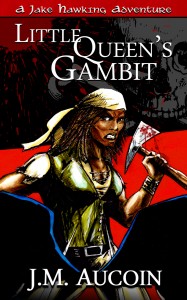 brush by her skin. She did not dodge the second blow though, a heavy backhand from his fist across her jaw. She staggered, but righted herself in time to parry a cut from the left with her dagger. Marshal’s attack was relentless, never giving Queen an inch to settle or a moment to catch her breath. It was a far cry from when they were arm wrestling at the Dogwatch Tavern. She knew he toyed with her then, but to what extent she did not truly understand until now. His attacks flowed from one to another with the intensity of the Caribbean sun and the power of a flash flood. It took all Little Queen’s strength and instincts to keep his sword at bay. Glow from the lanterns washed over the blade and it reminded her of a wolf licking its chops.
brush by her skin. She did not dodge the second blow though, a heavy backhand from his fist across her jaw. She staggered, but righted herself in time to parry a cut from the left with her dagger. Marshal’s attack was relentless, never giving Queen an inch to settle or a moment to catch her breath. It was a far cry from when they were arm wrestling at the Dogwatch Tavern. She knew he toyed with her then, but to what extent she did not truly understand until now. His attacks flowed from one to another with the intensity of the Caribbean sun and the power of a flash flood. It took all Little Queen’s strength and instincts to keep his sword at bay. Glow from the lanterns washed over the blade and it reminded her of a wolf licking its chops.
For the first time since she escaped Barbados, Little Queen felt fear.
She caught the edge of the sword with her axe and twisted, locking the blade between its head and the wooden shaft. She rushed in, her dagger aimed for Marshall’s chest, but he grabbed her at the wrist before its tip made its mark. He leaned in, his large and crooked jaw set in a haughty, but grotesque smile. He wrenched her arm, sending the dagger clanking off the wooden deck.
The fight is a continuation of the friendly(ish) arm wrestling contest between Little Queen and Marshall, taking to a new level and with much higher stakes. Readers also learn a little more about Queen’s history during the fight and her relationship/friendship with Captain Hawking… elements that push the story forward and build the world and characters around it.
I often enjoy seeing characters cleverly get their way out of trouble, but sometimes, as Don Francisco Quevedo says often in the Alatriste series: There’s no choice but to fight. Hawking and Little Queen provide the best of both worlds when I’m writing.
En garde!
 To learn more about Justin, visit his website & blog at www.JMAucoin.com. His swashbuckler stories are available on Amazon for Kindle, B&N for the Nook, and on Smashwords for other e-reader and web browser file types. When not writing about sword fights, he practices and studies historical fencing, and is an active stage combatant for theater and indie-films in the New England area.
To learn more about Justin, visit his website & blog at www.JMAucoin.com. His swashbuckler stories are available on Amazon for Kindle, B&N for the Nook, and on Smashwords for other e-reader and web browser file types. When not writing about sword fights, he practices and studies historical fencing, and is an active stage combatant for theater and indie-films in the New England area.
